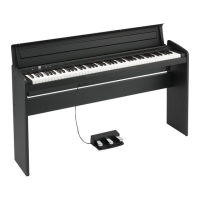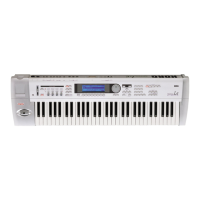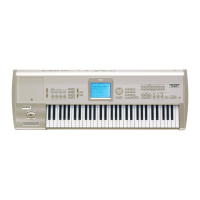PROG P0: Play 0–7: Sampling/Audio In
9
Note: If the EXB-FW option is installed, you can use the 5, 6
switches and 5, 6 sliders to control the above PLAY/MUTE,
SOLO On/Off, and Audio Volume settings of the FireWire
inputs.
0–7a: Audio Input
Use Global Setting [Off, On]
Programs can use the single, Global audio input mixer
setup, or can instead have their own custom settings. The
Global settings are described under “0–3: Audio,” on
page 360.
When Use Global Settings is On, the Program uses the
Global settings. This is the default, and lets you change
freely between different Programs and Combinations
without affecting the audio inputs.
Note: FireWire 1 and 2 are enabled if the EXB-FW option is
installed.
Also, any edits made on this page will affect the Global
setting, along with any other Programs, Combinations, or
Songs which use the Global setting.
On the other hand, it may sometimes be convenient to save
a particular mixer setup with an individual Program, to set
up special sub-mixer settings or effects processing for
particular inputs. For example, you can set up a Program to
use a mic input with a vocoder, as described under
“Example: Vocoder (Program)” on page 424, and page 515.
In this case, set Use/Edit Global Setup to Off, and the audio
inputs will use the Program’s custom settings.
Input [Analog, S/P DIF, (FireWire)]
Analog: The INPUT 1 and 2 jacks will input mic level or line
level signals.
S/P DIF: A digital audio from the S/P DIF IN jack will be
input. Connect the digital output of your instrument or DAT
etc. to the S/P DIF IN jack. Input1 shown below specifies the
input to the L side of S/P DIF, and Input2 specifies the input
to the R side. The S/P DIF input/output supports 48 kHz
sample rates.
If you want to use S/P DIF, set System Clock to S/P
DIF. For more information, please see “System Clock”
on page 359.
FireWire: If the EXB-FW option is installed, input a digital
audio signal from the FireWire connector. The sample rate of
the FireWire input/output is 48 kHz.
Note: For details on FireWire input, please see “M3 Editor/
Plug-In Editor Manual” (PDF).
Note: You can make settings independently for analog and
S/P DIF. Make this Input setting first, and then specify the
Input1 and Input2 parameters. You can also input from
multiple external audio sources at the same time.
Input 1, Input 2:
PLAY/MUTE [PLAY, MUTE]
This shows whether the external audio signal being input is
in PLAY or MUTE status.
You can use the MIX PLAY/MUTE 1–4 switches to change
this.
Mute: The input sound will be muted (silent).
Play: The input sound will be heard.
Tip: You can use the control surface to control this parameter.
For more information, please see “Using the control surface
to make audio input settings” on page 8.
SOLO On/Off [Off, On]
This indicates the SOLO status of each external audio signal
input.
If the menu command Panel-Switch Solo Mode is checked,
you can use the MIX PLAY/MUTE 1–4 switches to change
this setting.
Tip: You can switch the Panel-Switch Solo Mode on/off by
holding down the ENTER switch and pressing numeric key
1.
Sound will be output only from channels for which SOLO is
On. Other channels will be muted.
The Solo function includes the oscillators in Program mode,
the timbres in Combination mode, and MIDI tracks and
audio tracks in Sequencer mode.
The way in which the Solo function operates will depend on
the setting of the Exclusive Solo menu command in each
mode.
Exclusive Solo Off: You can solo multiple audio inputs. The
solo status will change each time you press Solo On/Off.
Exclusive Solo On: Pressing a SOLO button will solo only
that audio input.
The SOLO setting is not memorized when you Write a
Program.
Tip: You can hold down the ENTER switch and press
numeric key 2 to switch Exclusive Solo On/Off.
Tip: You can use the control surface to control this parameter.
For more information, please see “Using the control surface
to make audio input settings” on page 8.
Level [000...127]
This controls the level of the external audio signal. The
default is 127.
The analog audio signals from AUDIO INPUTS 1, 2 are
converted into digital form by an A/D converter. This
parameter sets the level of the signal immediately after this
conversion.
AUDIO INPUT 1, 2
ADC
Analog to
Digital
Converter
LEVEL
(MIC/LINE)
(MIN...MAX)
ADC OVERLOAD !!
L-Mono
R-Mono
Stereo
REC Sample Setup
"Mode" (0–7b)
"Level"
[127=0dB]
"Pan"
Insert
Effects
CLIP !!
"Recording Level" (0–7c)
[–inf ... 0.0dB ... +18.0dB]
"Audio Input" (0–7a)
L/MONO
"Source Bus" (0–7b)
= L/R
R
AUDIO
OUTPUT
Bus(IFX/Indiv.)
= L/R or IFX1-5
Total
Effects
Master
Effects
S/P DIF IN (L, R)
"Level"
[127=0dB]
"Pan"
Insert
Effects
FIREWIRE IN (L, R)
OPTION:
"Level"
[127=0dB]
"Pan"
Insert
Effects
Sampling
Audio input/output

